


建筑设计 北京市建筑设计研究院股份有限公司 马泷工作室
合作设计 上海天华建筑设计有限公司
建设地点 上海青浦
方案状态 在建
建筑面积 398,000平方米
本文文字由马泷工作室-BIAD提供。
我们不了解的美的
过去十年,美的集团通过数字化升级与海外并购,从一家知名的白色家电企业转型为全球领先的科技创新公司。2024年,美的集团在全球500强中位列277位。美的全球创新园区的设计目标,正是为这一企业吸引全球顶尖的科技人才,提供世界一流的办公场所,打造一座面向未来的科技创新中心,为“基础科学、人工智能、机器人技术、智慧物联”四大板块提供全球研发平台,体现企业“科技尽善,生活尽美”的核心理念。
Over the past decade, Midea Group has transformed from a well-known major appliance company into a globally leading technology and innovation firm, driven by digital upgrades and overseas acquisitions. In 2024, Midea Group ranked 277th among the Fortune Global 500. This project aims to provide world-class office facilities to attract top global talent to Midea, while creating a futuristic hub for technology and innovation. It will serve as a global R&D platform for four key areas: foundational science, artificial intelligence, robotics, and smart IoT. The project embodies Midea Group’s core vision: “Technology for the betterment of life.”
项目位于上海市西虹桥商务区,临近国家会展中心和虹桥国际机场,总用地面积80180平方米,建筑面积39.8万平方米,综合容积率2.5,包含研发办公15万平方米、研发实验5万平方米、园区配套设施3万平方米、配套酒店2万平方米、配套商业1万平方米。
Midea’s Global Innovation Center is located in the Hongqiao Business District of Shanghai, close to the National Exhibition and Convention Center and Hongqiao International Airport. The center covers 80,180 square meters of land, with a total floor area of 398,000 square meters and a floor area ratio of 2.5. The project includes 150,000 square meters for R&D offices, 50,000 square meters for laboratories, 30,000 square meters for campus facilities, 20,000 square meters for a hotel, and 10,000 square meters for commercial spaces.
由马泷工作室提出的概念方案设计于2020年赢得国际竞标,2021年动工建设,属于上海市重大工程项目。建成后将提供15000人研发、办公、生活的企业总部与创新型科技社区。
The concept design won an international competition in 2020, and construction began in 2021. Once completed, the center will provide a headquarters and innovation community to support the work and lives of 15,000 employees.

▲ 方案视频介绍 ©马泷工作室-BIAD
▲ 项目建设现场 摄影:存在建筑-建筑摄影
超尺度的天空之城
项目周边有着虹桥机场、国展中心这样的超级城市尺度,也有着飞机航线、高速公路这样的快捷城市速度。同时,虽然建筑基地被城市道路分割为南北两个部分,分别服务于两大事业部,但是无论建筑功能还是城市总体环境都要求园区是连续和开放的。为此,建筑设计选择两个超尺度的L型办公形体相互连接,形成240×240米的正方形巨构建筑嵌入城市肌理之中,通过漂浮的建筑构型,解答建筑与城市空间、建筑与自然环境、建筑与人文环境之间的关系,塑造建筑的社会性与科技感。
The project site is surrounded by large-scale urban landmarks such as Hongqiao Airport and the National Exhibition and Convention Center, along with fast highways and flight paths. The site is divided into two sections by city roads, each serving one of two major business units. In this context, both the building's functions and the public spaces connecting to the city are designed to be open and connected. To achieve this, the design features two large L-shaped office buildings that fit together to form a massive 240m x 240m square structure, seamlessly blending into the natural landscape of the podium. The floating architectural form helps explore the relationship between the building, the city, nature, and human interaction, aiming to create a space that balances social connection with a sense of technological sophistication.




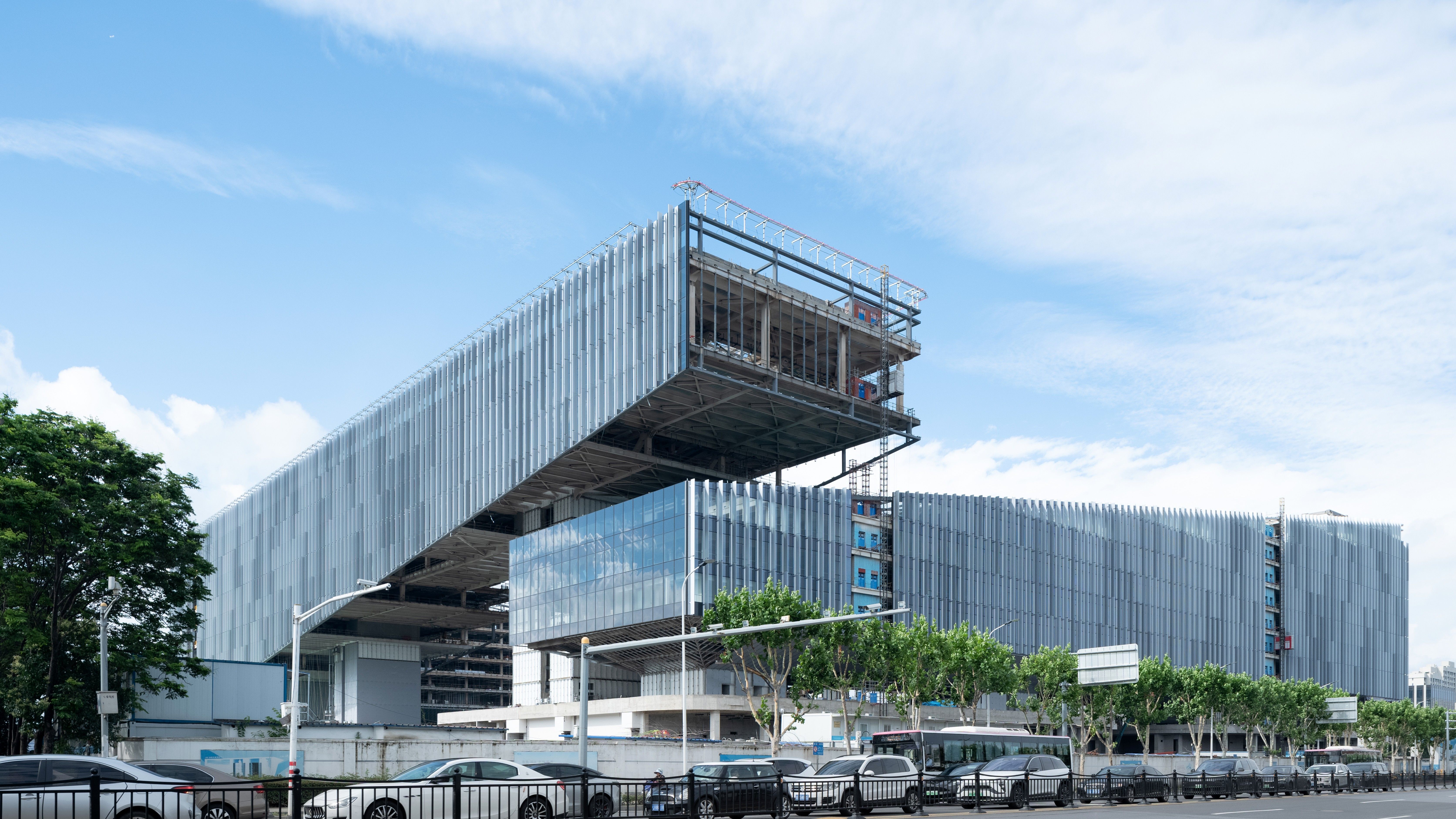
伴随着科学技术的迅速迭代,现代科技企业的工作模式和面貌也在快速改变,为科技总部的每一位员工创造能够互联互通、激发创造、释放天性、回归本真的工作生活环境,是业主对于办公空间的核心目标。我们通过创造一座森林之上的科技之城,回应了科技企业开放共享的核心需求以及场地周边复杂的城市要素,同时两栋相互关联的L型办公建筑构成一组各自独立却又保持沟通的形态,员工们可以从空中办公、裙房屋面、景观地面、下沉广场四个维度进行连接。
With the rapid advancement of science and technology, the way modern tech companies work is changing. Our goal is to create a work-life environment at this tech headquarters that is connected, inspiring, freeing, and true to itself for every employee. This is the core idea behind the office design. By imagining a tech city floating above a forest, we address the need for openness and collaboration, which are key to tech companies, while also taking into account the complex urban surroundings. The two interlinked L-shaped office buildings form a unified yet distinct structure, with pathways that connect sky offices, rooftop gardens, landscaped grounds, and sunken plazas in multiple ways.



森林上的科技公园
设计构思源于人与自然、科技与自然、科技与生活的碰撞与交融,为科技创新企业提供一个具有工作、自然、人文相互融合,面向未来的、蓝绿交融的科技园区。园区的建筑形体从大地中生长出来,与起伏的地景森林相互融合,塑造多样的自然环境。
This design concept emerges from a harmonious convergence of three essential themes: the relationship between people and nature, technology and the natural world, and technology and daily life. Envisioned as a forward-looking campus for tech innovation, this space is crafted to seamlessly blend work, nature, and human culture. The architecture rises organically from the landscape, merging with the undulating forest terrain to create a richly diverse environment.


项目的设计有别于传统园区的布局,一切功能个体都融合在总体秩序之中——“All in One”。建筑与森林形成一个整体,独特创新的空间层出不穷,一座生态化、人性化、智慧化的科技总部应运而生。园区主要的功能空间,研发办公与酒店公寓飞架于景观森林之上,形成相互融合嵌套的构型,通过分散设置的12组竖向核心筒与地面空间连通,形成人工与自然、科技与自然的交织。
The design of Midea’s Innovation Center diverges from conventional campus layouts; instead, every functional element is interwoven within a unified structure—an “All in One” concept. Here, the buildings and forest form a single, cohesive entity, unfolding unique and inspiring spaces to embody an ecological, human-centered, and intelligent tech hub. Key functional areas—such as the R&D offices and hotel residences—are gracefully elevated above the forested landscape, establishing a composition that is both interwoven and layered. Twelve thoughtfully positioned vertical cores provide seamless connections between these elevated structures and the ground below, weaving together the natural and built environments, while bridging the realms of technology and nature.


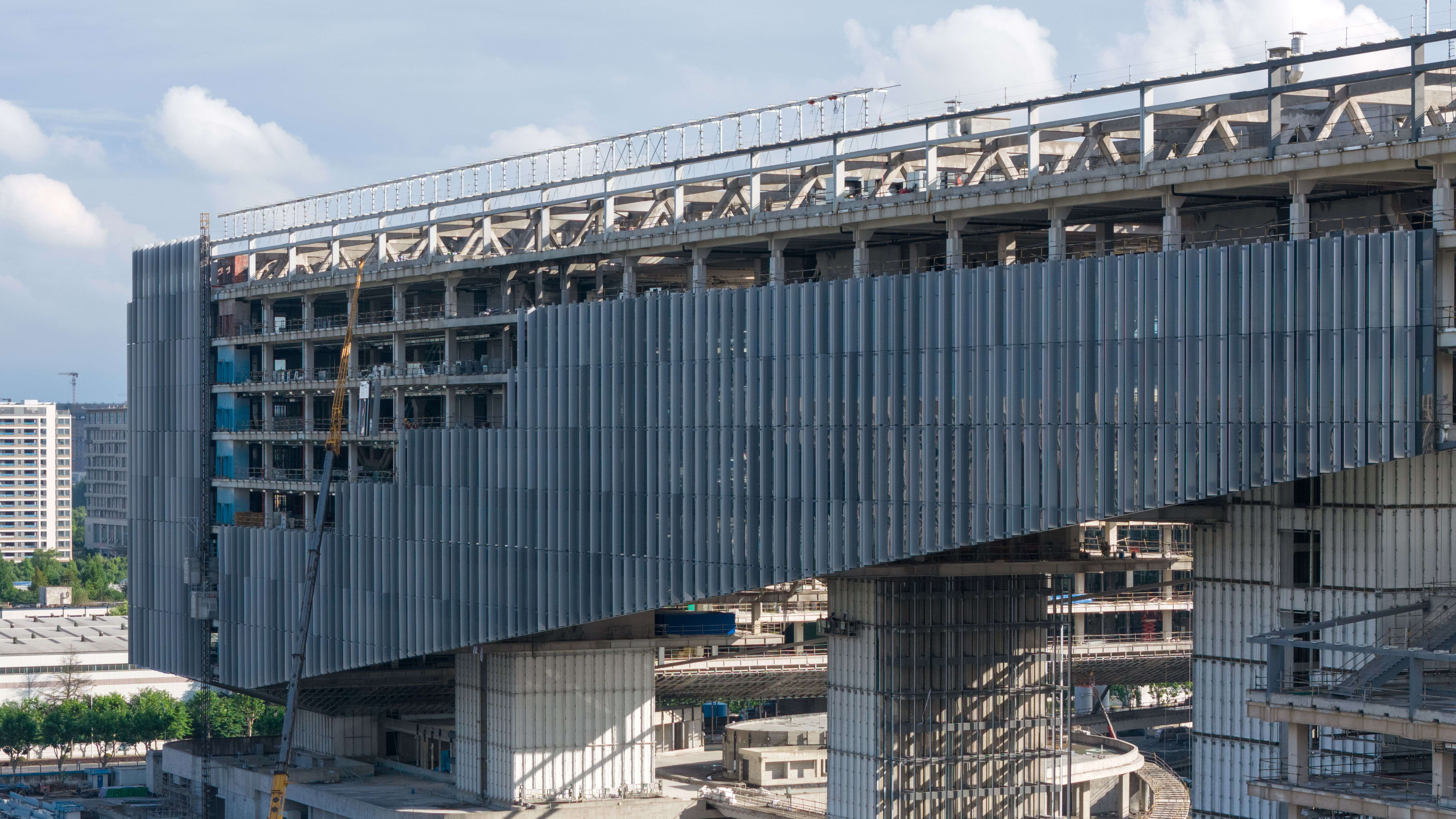

近地空间隐于景观
近地空间采用流动曲线整合地面广场、下沉庭园、裙房屋面花园,塑造柔和流通的自然界面,将配套裙房隐蔽于地景森林之中。树木从用地边缘,沿着逐渐升起的裙房顶部延伸,穿过架空的建筑实体到达中央森林广场,再沿着竖向交通系统逐级升起,到达空中的每一个室外绿色庭园,直至60米的最高屋面,远远望去建筑和树木交相辉映。
The design of the near-ground spaces uses gentle, flowing curves to connect the ground plaza, sunken gardens, and rooftop terraces, creating a soft, natural boundary that nestles the podium within a forested landscape. Trees begin at the site’s edges and extend up along the gradually rising rooftop, weaving through the elevated building structures to reach a central forest plaza. From there, they continue upward along vertical pathways to outdoor garden terraces, finally reaching the highest rooftop at 60 meters. From a distance, the buildings and trees blend beautifully together, creating a harmonious scene where architecture and nature are in perfect balance.

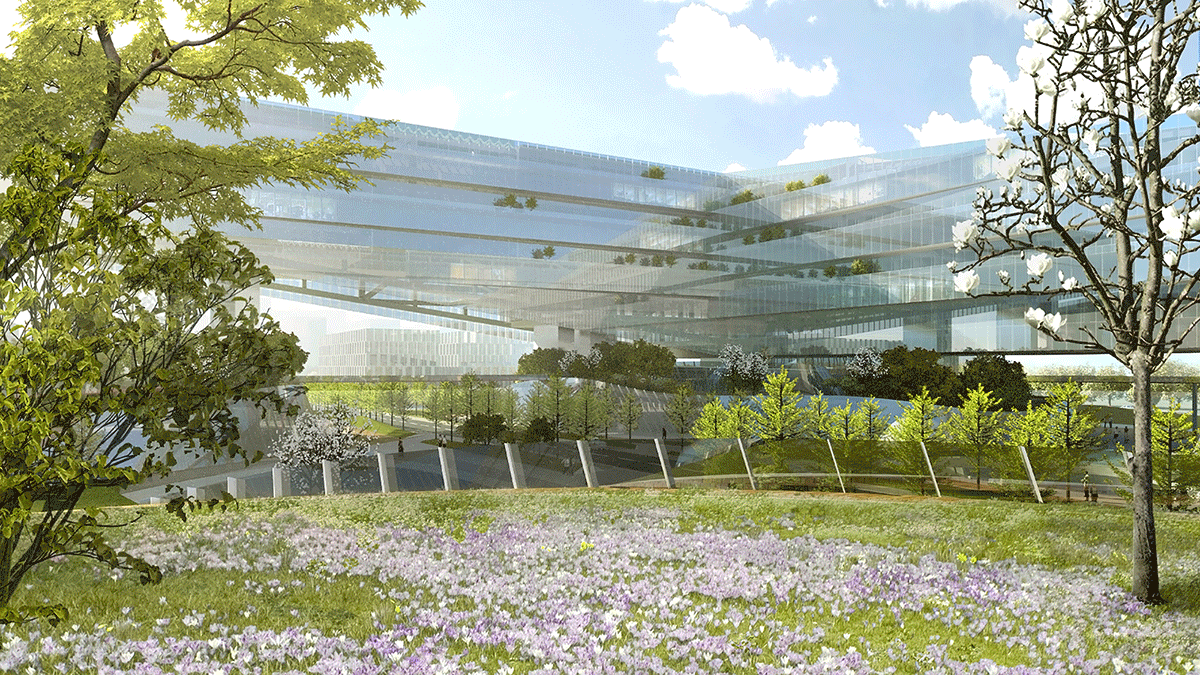

建筑裙房部分由自然景观屋面覆盖,包含接待大堂、展示空间、多功能厅、文体设施、商业配套等,在用地南北方向形成与城市道路平接的入口和中央广场,将城市空间引入场地内部的共享展厅、交往、运动、商业设施,鼓励员工与社区、人与自然的亲近与交流。人行漫步道串联西侧城市运动公园、园区地景平台、部分连通上部共享中庭,提升不同空间可达性,丰富园区立体空间关系,提升园区步行体验。
The podium is covered with landscaped roofing and includes spaces such as the reception lobby, exhibition areas, multipurpose halls, recreational facilities, and retail amenities. Entrances and a central plaza align with city roads in the north-south direction, drawing the city’s energy into shared spaces for exhibitions, gatherings, sports, and shopping, encouraging connections between employees, the community, people, and nature. Pedestrian walkways link the urban sports park on the west, landscape platforms throughout the campus, and some paths lead up to shared atriums, enhancing access, enriching the campus’s spatial connections, and making it a pleasant place to walk and explore.


水平连续办公空间
研发办公建筑主体采用钢结构体系,空间布局摆脱了传统办公水平分区、垂直复制的单调模式,以大开间办公场所呈L型展开,宽度40米、最大长度440米,超尺度水平连续办公空间突破了楼板和墙体的限制,连续办公场所可以超过20000平方米。
The R&D office building is designed with a steel frame system, moving away from the traditional segmented layouts. Instead, it features a vast, L-shaped open-plan office space that is 40 meters wide and up to 440 meters long. This large, continuous workspace breaks free from the limitations of floors and walls, offering over 20,000 square meters of uninterrupted office area.
当今大部分的科技研发办公场景是在电脑密布的员工工位、便于随时研讨交流的会议空间,以及舒适放松的共享空间完成的。由于办公空间的工作绝大部分是通过电脑屏幕完成,所以对于自然采光的需求相比传统工位有较大下降,相反由于员工之间快速语言交流的增加,对于小团队的组织方式、对于听觉视觉的交互与控制、空气的新鲜程度和温湿度控制更加敏感起来。同时办公空间与交往空间的分离已经成为新型办公模式的特出特征。
In modern tech workplaces, most tasks are done at computer workstations, in meeting areas that encourage spontaneous discussions, and in comfortable shared spaces. Since much of the work is computer-based, the need for natural light is lower compared to traditional offices. However, there is a greater focus on factors like team organization for quick communication, the quality of sound and visuals, air quality, and temperature control. The separation of work areas from social spaces has become a defining feature of modern office design.




员工也可以通过室外平缓的楼梯到达建筑室内与屋面花园的每一个位置,既是建筑通风采光的廊道,也是连续立体绿化、建筑空中庭园和员工会议休闲的绝好之地。逐层退台的屋顶花园、错层布置的水平露台,作为办公空间的延展,形成人与自然沟通对话的多层次空间。
Employees can access all areas of the building and rooftop gardens via gently sloping outdoor stairways. These stairways not only provide natural light and ventilation but also offer spaces for vertical landscaping, sky gardens, and casual meeting spots. The tiered rooftop gardens and stepped terraces extend the office space, creating a multi-layered environment where people can connect with nature.
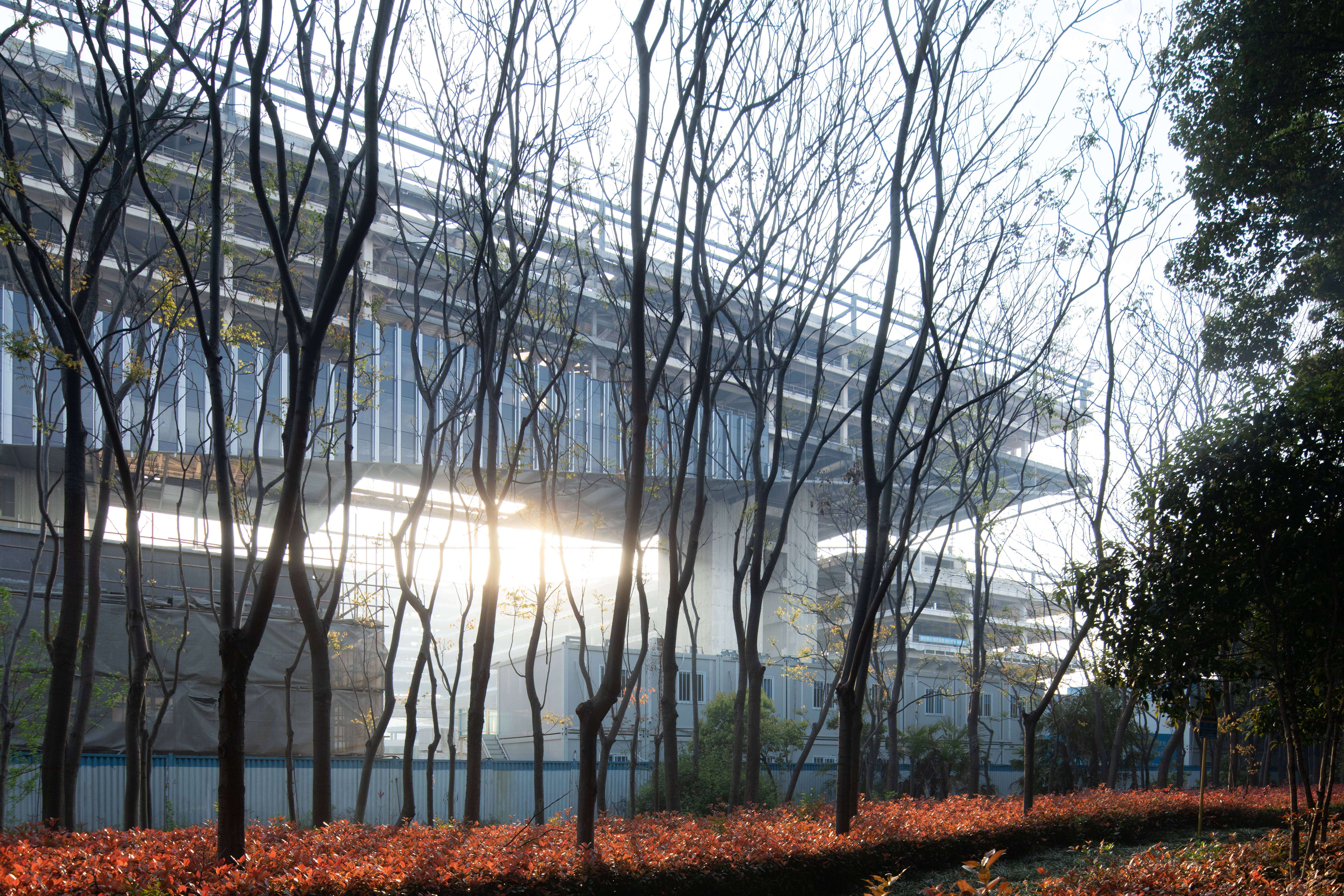

智慧赋予全新内核
科技企业在当今时代表着最先进的科学技术与生产力发展方向,科技、技术如何通过建筑空间这一载体与使用者进行关联与交互,成为科技总部建筑带来的新的需求与挑战。为科技总部的每一位员工创造一个能够互联互通、激发创造、释放天性、回归本真的工作生活环境,塑造一个具有智能思维、智慧反馈的园区与物理空间,成为业主的核心诉求,同时也是我们建筑师的设计目标,这对科技总部建筑的智慧化发展与智慧建筑营造提出了更高的挑战与要求。
In today's world, technology companies stand at the forefront of scientific progress and productivity. One of the main challenges in designing tech headquarters is creating spaces that connect and engage users with technology. The goal is to design a work environment that is interconnected, sparks creativity, encourages personal freedom, and feels authentic, while also shaping a campus that embodies intelligent thinking and responsive innovation. This vision is the key priority for both the client and the architect, setting higher expectations for the development of smart, innovative tech headquarters.
美的全球创新园区从建筑方案设计阶段开始即采用BIM三维正向协同设计方法与流程,通过高精度与高深度的设计控制,确保方案设计概念的落地与执行,最大限度降低设计偏离,在整体项目深化设计与实施过程中保持数字、数据传递,为营造新形的数字孪生智慧园区奠定良好的基础。
From the very beginning of the design process, Midea’s Global Innovation Campus has embraced a BIM (Building Information Modeling) 3D collaborative approach. This method ensures precise design control, helping to bring the concept to life with minimal deviations. Throughout the design and implementation process, digital data flows seamlessly, laying a solid foundation for the creation of a cutting-edge, smart campus built on the principles of digital twins.
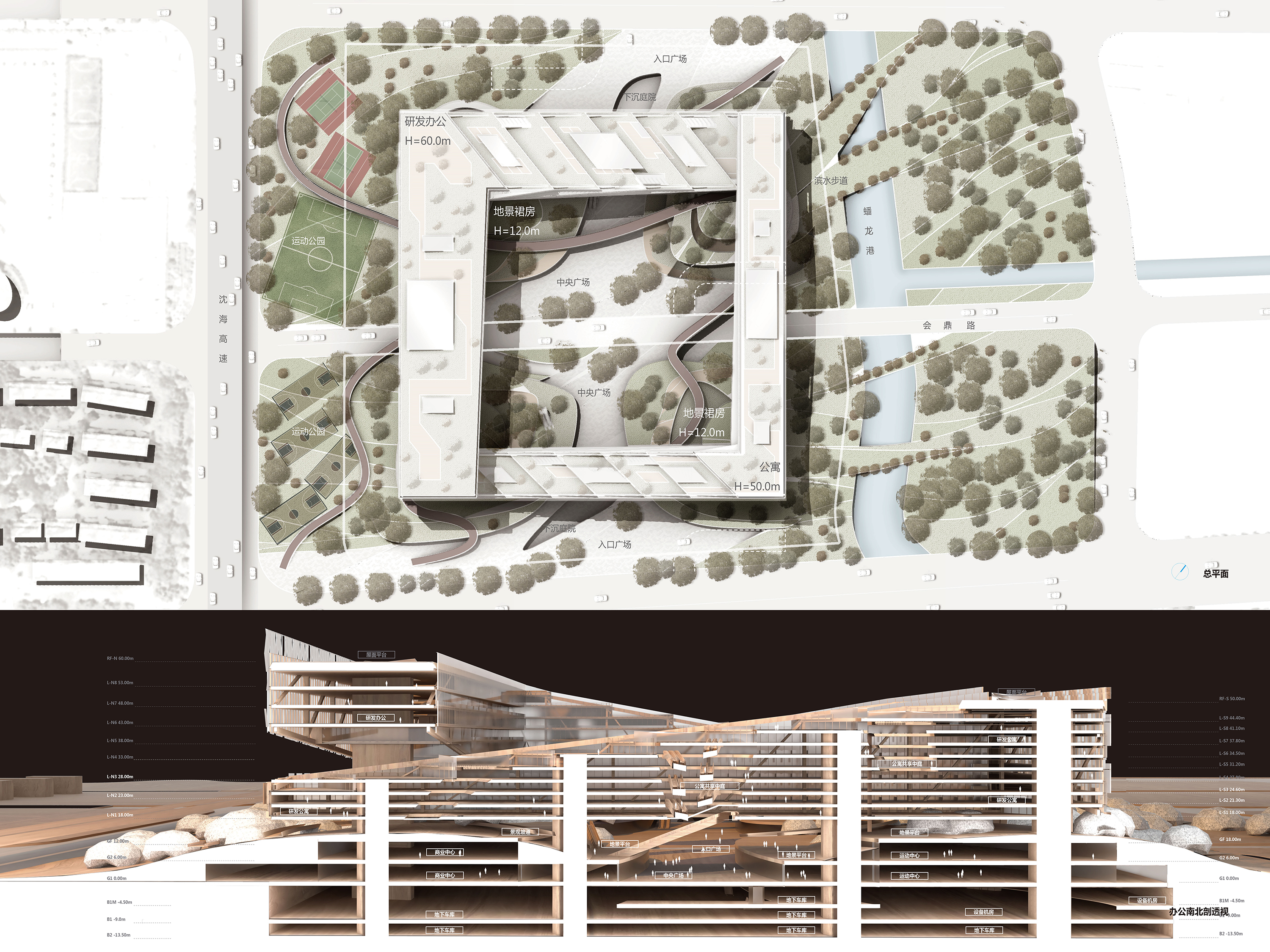


完整项目信息
项目名称:上海美的全球创新园区
业主:美的集团
建设地点:上海市,西虹桥商务区
建筑设计:北京市建筑设计研究院股份有限公司 马泷工作室
用地面积:80,180平方米
建筑面积:398,000平方米
建筑高度:62.5米
建筑层数:地上10层 地下3层
结构形式:复合钢结构体系(下部:钢筋混凝土结构,上部:钢骨混凝土+钢结构+斜拉索+巨型钢桁架)
设计时间:2020—2022
建设时间:2021—2025
总建筑师:马泷
建筑团队:马泷,褚以平,王欢欢,冉展,丛晓,王斌,祁美蕙
结构顾问:BIAD-复杂结构研究院
合作设计:上海天华建筑设计有限公司
摄影:存在建筑-建筑摄影
版权声明:本文由马泷工作室-BIAD授权发布。欢迎转发,禁止以有方编辑版本转载。
投稿邮箱:media@archiposition.com
上一篇:RPBW新作:伦敦帕丁顿广场,历时十年终建成
下一篇:杭州K11 ATELIER及瑰丽酒店,方案公布:奥雷·舍人打造“城市峡谷”